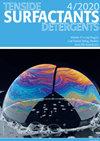苯与1-十二烯烷基化用cucl2修饰离子液体
IF 1.2
4区 工程技术
Q4 CHEMISTRY, APPLIED
引用次数: 0
摘要
摘要苯和1-十二烯经常被烷基化以产生线性烷基苯(LAB)。LAB是生产线性烷基苯磺酸钠(LAS)的原料,LAS是一种非常重要的阴离子表面活性剂,用于工业清洁和商业洗衣过程,以及家用洗衣洗涤剂。在本研究中,我们研究了用CuCl2修饰的[Et3NH]Cl–2AlCl3作为苯与1-十二烯烷基化的催化剂的使用,特别是考察了反应条件对产物活性的影响。结果表明,1-十二烯的转化率为100.0 % LAB的选择性为93.79 % 当苯/1-十二烯摩尔比=6,反应温度=25时,可以得到 °C,反应时间=10 min,搅拌速度为1000 rpm和添加5.0 摩尔 % CuCl2)。催化剂浓度为7.0 摩尔 %. 在加入CuCl2之前和之后进行FTIR和31P-TMPO-NMR测量以表征离子液体。在加入CuCl2之后,发现离子液体的酸度已经降低。还对催化剂的再生进行了研究,并确定了催化剂失活的原因。结果表明,CuCl2对离子液体进行了改性,降低了苯/1-十二烯的比例,但保持了较高的产物选择性。本文章由计算机程序翻译,如有差异,请以英文原文为准。
CuCl2-modified ionic liquids for alkylation of benzene with 1-dodecene
Abstract Benzene and 1-dodecene are often alkylated to produce linear alkylbenzene (LAB). LAB is the raw material for the production of linear alkylbenzene sulfonate (LAS), a very important anionic surfactant used in both industrial cleaning and commercial laundry processes, as well as in household laundry detergents. In the present study, we investigated the use of [Et3NH]Cl–2AlCl3 modified with CuCl2 as a catalyst for the alkylation of benzene with 1-dodecene, specifically looking at the effect of reaction conditions on product activity. The results showed that a conversion of 1-dodecene of 100.0 % and a selectivity of LAB of 93.79 % could be obtained when the following ideal reaction conditions were present: molar ratio of benzene/1-dodecene = 6, reaction temperature = 25 °C, reaction time = 10 min, stirring speed of 1000 rpm and addition of 5.0 mol % CuCl2). The catalyst concentration was 7.0 mol %. FTIR and 31P-TMPO-NMR measurements were performed to characterise the ionic liquid before and after the addition of CuCl2. After the addition of CuCl2, it was found that the acidity of the ionic liquid had decreased. The regeneration of the catalyst was also investigated and the cause of inactivation of the catalyst was determined. The results showed that CuCl2 modified the ionic liquids and decreased the benzene/1-dodecene ratio, but the high product selectivity was maintained.
求助全文
通过发布文献求助,成功后即可免费获取论文全文。
去求助
来源期刊

Tenside Surfactants Detergents
工程技术-工程:化工
CiteScore
1.90
自引率
10.00%
发文量
57
审稿时长
3.8 months
期刊介绍:
Tenside Surfactants Detergents offers the most recent results of research and development in all fields of surfactant chemistry, such as: synthesis, analysis, physicochemical properties, new types of surfactants, progress in production processes, application-related problems and environmental behavior. Since 1964 Tenside Surfactants Detergents offers strictly peer-reviewed, high-quality articles by renowned specialists around the world.
 求助内容:
求助内容: 应助结果提醒方式:
应助结果提醒方式:


